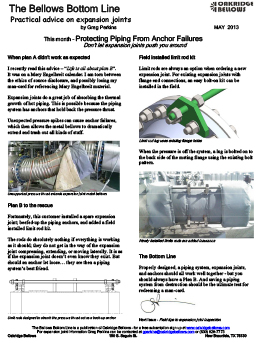Protecting Piping From Anchor Failures

Don’t let expansion joints push you around.
When plan A didn’t work as expected I recently read this advice – “Life is all about plan B”.
It was on a Mary Engelbreit calendar. I am torn between the ethics of source disclosure, and possibly losing my man-card for referencing Mary Engelbreit material.
Expansion joints do a great job of absorbing the thermal growth of hot piping. This is possible because the piping system has anchors that hold back the pressure thrust.
Unexpected pressure spikes can cause anchor failures, which then allows the metal bellows to dramatically extend and trash out all kinds of stuff.
Unsupported pressure thrust extends expansion joint metal bellows Plan B to the rescue Fortunately, this customer installed a spare expansion
joint; beefed-up the piping anchors, and added a field installed limit rod kit.
The rods do absolutely nothing if everything is working as it should; they do not get in the way of the expansion joint compressing, extending, or moving laterally. It is as if the expansion joint doesn’t even know they exist. But should an anchor let loose… they are then a piping system’s best friend.
Limit rods designed to absorb the pressure thrust act as a back-up anchor Field installed limit rod kit Limit rods are always an option when ordering a new expansion joint. For existing expansion joints with flange end connections, an easy bolt-on kit can be installed in the field.
Limit rod lug uses existing flange holes When the pressure is off the system, a lug is bolted on to the back side of the mating flange using the existing bolt pattern.
Newly installed limits rods are added insurance
The Bottom Line
Properly designed, a piping system, expansion joints, and anchors should all work well together – but you should always have a Plan B. And saving a piping system from destruction should be the ultimate test for redeeming a man-card.


